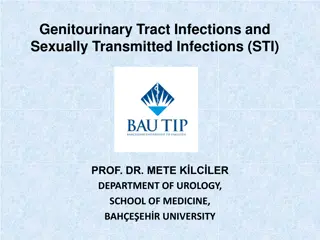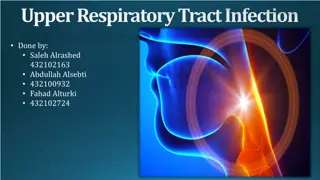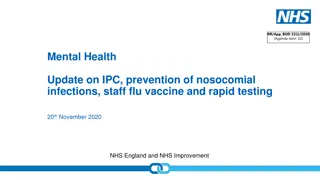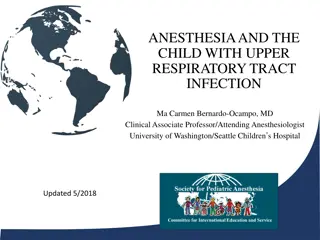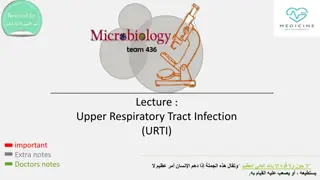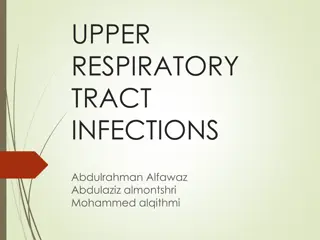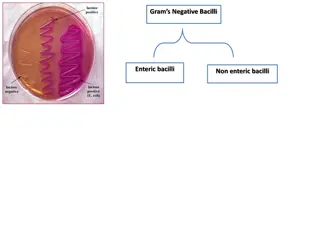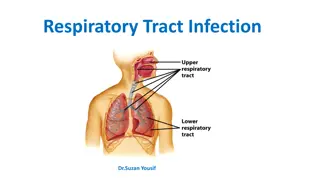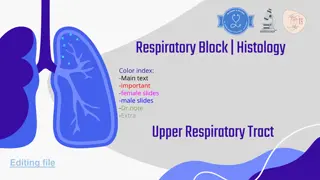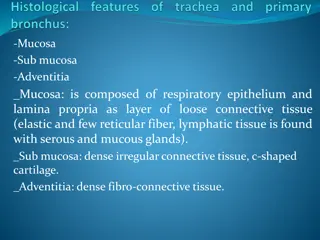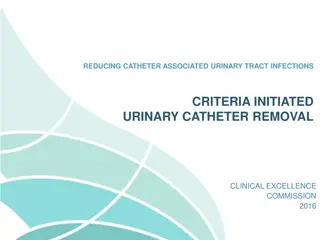Comprehensive Pathway for Managing Respiratory Tract Infections and COVID-19 in Scottish NHS
Consideration of a community-based approach to managing respiratory infections and potential/confirmed COVID-19 cases is crucial in the Scottish NHS. This pathway emphasizes the collaboration between teams, appropriate patient management in healthcare settings, minimization of healthcare-associated COVID-19 risks, prioritization of testing based on guidelines, utilization of telemedicine, and coordination between primary and secondary care. Addressing critical care capacity challenges, up-skilling staff, and enhancing communication are highlighted, along with risk factors for deterioration and recommendations for clinical assessments.
- Respiratory infections
- COVID-19 management
- Community healthcare
- Healthcare pathways
- Patient management
Uploaded on Sep 22, 2024 | 0 Views
Download Presentation

Please find below an Image/Link to download the presentation.
The content on the website is provided AS IS for your information and personal use only. It may not be sold, licensed, or shared on other websites without obtaining consent from the author. Download presentation by click this link. If you encounter any issues during the download, it is possible that the publisher has removed the file from their server.
E N D
Presentation Transcript
Community pathway for managing respiratory tract infection/possible COVID-19/definite COVID-19 in Scottish NHS. Stage 3 Key points This pathway must be considered as part of a whole system response, and will rely on teams working together. Patients must be managed in the community where clinically possible Secondary care should only be for clinically unwell patients , acute care should be available for advice regarding admissions. Patients presenting with respiratory symptoms should be regarded as possible cases and should be managed in separate healthcare settings ( hub or designated practice) to those without respiratory illness until COVID-19 is excluded. Risk of healthcare associated COVID-19 needs to recognised and should be minimised as much as possible Existing flu pandemic plans are likely to be helpful templates for clinical services to model new local pathways on. Testing is likely to be overwhelmed in early weeks and will need to be focused according to clinical/organisational priority and follow national guidance Telemedicine is a useful tool support to enhance and expand this should be considered a priority The ability for secondary care to rapidly discharge all patients ( with clear plans) is essential to facilitate patient flow HSCP community support and care requires to be robust to avoid delayed discharges or unnecessary admissions Elective activity will require to be curtailed. Consideration should be given to enhanced healthcare support in community settings by shifting resources. e.g. To nursing homes and other community healthcare initiatives e.g. OPAT that would prevent admission to secondary care or facilitate rapid discharge. Consideration should be given to what primary care can stop doing to free up capacity both in and out of hours Critical care capacity is likely to be highly stretched. Up-skilling gen med physicians in HDU level care such as inotropic/NIV/HFNO may be of value in certain hospital settings. Medical and nursing staff will need reassurance that the medico legal aspects of providing care out with the scope of their usual professional competencies and under extreme pressure are considered and they will be supported fully in any resulting safety/governance concerns that result from doing the best they can in extreme circumstances. communication between primary care and secondary care needs to be robust both in the admission and discharge process.
National COVID-19/respiratory line NHS111 For possible concerned or known positive cases Cough / fever No co-morbidities New Breathless (MMRC 1+ *) or Risk factors and fever or cough No breathlessness Local Hub Direct Primary care presentations-local pathways Primary care with senior decision maker Worsening advice, based on breathlessness Self- isolate per current guidelines Clinical Assessment NB Key symptom is breathlessness Clinical concern Communication difficulties/ capacity concerns If VC available, RR 24 Complex COVID Severity Risk Factors No concerns Yes, definite concern Yes, possible concern Next day follow up if risk factors for deterioration* Worsening advice if no co- morbidities. Follow self isolation guidance Covid Hospital Assessment Assessment Clinic
Risk Factors for deterioration Age >60 Respiratory or cardiac comorbidities Immunosuppression including cancer Frailty Diabetes MMRC scale
Pathway for Pregnant Women Central COVID-19 NHS24 111 help line For pregnant women with respiratory symptoms at any stage of pregnancy *Risk Factors for Deterioration Respiratory or cardiac comorbidities Immunosuppression Diabetes (type 1&2 not gestational diabetes) Shortness of breath , Worsening respiratory symptoms OR Risk factors for deterioration * Cough/ Fever , no risk factors for deterioration* No breathlessness Refer to secondary care telephone contact with Maternity Triage, who will then advise according to: Advise:- Self isolate 7 days and inform primary midwife Call back if worsening symptoms or develop breathlessness No additional obstetric complications follow local health board policy for admission Additional obstetric complications admit to obstetric unit
Maternity Pathway from primary MW Woman presents as symptomatic to primary MW Risk Factors for Deterioration Respiratory or cardiac comorbidities Immunosuppressio n Diabetes (type 1&2 not gestational) In labour? Yes No Refer for combined assessment with obstetrician and physician in obstetric facility with isolation facility Central COVID-19 NHS24 111 help line For pregnant women with respiratory symptoms at any stage of pregnancy
HUB Primary care HUB staffed by senior clinical decision maker e.g. GP , consultant or band 8 nurse staff should be drawn from across the system Consider staff who may be advised to be non direct patient facing Will accept calls triaged initially by NHS 24 and other primary care providers Telemedicine centre ideally with access to video consultation e.g. Attend anywhere No patient facing role Will have access to local primary care records EMIS and Vision (where possible) and clinical portal Must have access to ADASTRA Will have a robust way to communicate with secondary care/SAS and COVID assessment clinic Has protocols for worsening advice
COVID Assessment Clinic Has ability to perform face to face assessments and take basic obs/NEWS/PEWS score Able to discharge patients back to community with some access to therapeutic options/prescribing 1 administrator 3 nurses (1 front door, 2 assessing/buddying) 1 senior decision maker* ideally with prescribing ability 1 full time domestic PPE (given likely to be high volume of COVID + should be resp PPE despite some cases being possible) Obs kit (temp / sats probe / BP) Testing kits ?limited medication to supply (asthma / LRTI) ?access to O2 IT infrastructure and needs to have links to vision/EMIS- GP record, with priority 1 coding also available on ECS *See slide 7
Patient criteria for ambulatory care Patient with borderline symptoms who would benefit from face to face clinical assessment Communication difficulties - Learning difficulties / Capacity issues / Language barriers Patients with complex COVID severity risk factors as identified in local hub but clinically well Those assessed by HUB as benefiting from NEWS score to support triaging decision Require to be able to attend the centre e.g. Mobility/transport considerations including ability to drive themselves and parking.
Flow Patient arrives (by appointment) Waiting Room Waiting room must have capacity to keep ?2-4 patients >2 metres apart Surgical Mask put on patient by staff in PPE * Obs taken (+/-Swabs ) Triage Room This needs cleaned between each patient Senior decision maker** review Consider admission if Sats<92% (if COPD, patients known baseline or <88%) RR 24, increased work of breathing, NEWS >2 Other clinical concerns Where possible additional community care services that may avoid admission should be utilised. E.G community respiratory nursing and elderly care hospital at home Home *following HPS guidance **see slide 11
Site location Acute site Pros Community Pros Can provide fuller work up if required (XRay / bloods / ...) Can provide COPD and other standard treatments if required Maybe able to use unused elective are(e.g. OP facility) Keeps patients away from acute site Easier parking Closer to the population Reduced media/ public interest Cons Limited access to other Rxs / investigations Requirement for potential further SAS transport if admitted to secondary care Cons Increased stress on acute site Expectation this is the responsibility of secondary care physicians Increased tendency to admit? May be more remote from population in some cases May not be suitable for rural settings
Potential Senior Decision Makers Respiratory clinicians Respiratory CNSs (Primary and Secondary Care) TB nurses ED Band 6+ nurses Acute medical / ED doctors GPs ANPs (Paediatric assessor if co-located with paeds pathway)
Secondary Care Interface with primary care/HUB/COVID assessment clinic Admission organisation Senior Coordinator (ideally Band 7 SCN) Coordinate admissions Coordination of bed / flow of ?COVID /known COVID + patient assessment unit (minimise time in waiting room) Stagger attendances with clinical prioritisation Liaise with Hub / Ambulatory Testing Centre / Primary Care Administrative support
Broader consideration for secondary care Patient flow and discharge Key principles Patient flow out of secondary care is essential to allow rapid and high quality care of all admitted patients including those with possible or proven COVID-19 Patients with COVID-19, possible or +, can be discharged based on clinical grounds and do not need to wait for a negative COVID test x2 as per current guidelines Discharge planning must be given the highest priority HSCP need to have the ability to rapidly provide care in community settings to facilitate discharge Patients may need to be moved to downstream settings in other facilities regardless of their postcode to facilitate bed availability at front door Redeployment of staff from areas where elective work has stopped may be required, including to support rapid discharge arrangements Where possible services that support community delivery of secondary care should be enhanced e.g. OPAT/respiratory and COPD nurse led services, hospital in the home etc. Consider utilising other staff if that service is suspended. Hospital pharmacy services must operate a 7 day a week service to support daily discharges throughout the day Twice daily senior ward rounds would be expected 7 days a week to allow immediate discharges. Consider use of nurse led discharge planning
Discharge criteria for a patient with known or possible COVID-19 No risk factors or co-morbidites Ability to isolate(self isolate or family isolation) Clinical improvement NEWS<2 Discharge with worsening advice and contact information for outstanding results Risk factors Ability to isolate(self isolate or family isolation) Clinical improvement NEWS <2 In patients with COPD O2 sats at base line or >88% on Room air Stable on discharge medication (i.e. If acute nebuliser started then off nebs for 24 hours) Or home with resp nurse support where available for + patients Or home after specialist respiratory advice No additional clinical concerns Discharge with worsening advice and contact information for outstanding results



